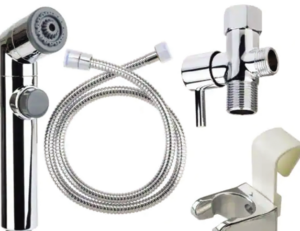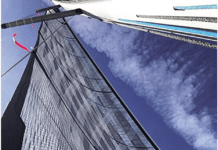Once again we broach a sanitation topic that folks would rather not talk about, and once again we’ve been surprised by the answers we found. Not the most glamorous investigations, but they address fundamental problems. The right holding tank treatment chemistry (“Solutions for a Stinky Holding Tank,” PS February 2021) and permeation resistant sanitation hoses (“Marine Sanitation Hose Test,” PS March 2012) keep boat stink at bay. Portable heads require different chemicals (“Controlling Porta Potty Odor,” PS September 2018), and when we downsized to a smaller boat, much to our surprise, we found happiness in a desiccating head (“Dissecting the Desiccating Head,” July 2021). We didn’t expect to. And that is why we test stuff.
We’d used bidets in hotels before but never thought much about it. They’re not an American tradition. Years later, the side effects of chemotherapy—near constant diarrhea—prompted reconsideration. Raw, sensitive skin made toilet paper unbearable. If there was a silver lining to this situation (and, in such moments, there is no other choice but to seek any glimmer we can) if we could cure our TP habit, we might never see another clogged head.
What follows is our experience with a home version, but so long as you have a pressurized freshwater supply somewhere on board, a boat version is within reach of the DIY plumber. Even if you don’t have a pressurized system, there are “portable bidets,” that might serve as well.
We settled on a well-reviewed bidet attachment by Tushy, the Spa 3.0, for about $140. It mounts under the existing seat, connects to cold and hot water with ¼-inch hoses, and requires no power. Since marine heads typically have non-standard seat attachment bolts, a little adaptation may be needed, but at most this involves drilling a few holes in plastic. If you have a manual head, the bidet inlet will need to be on the opposite side of the pump.
Hot water is not necessary. While some might prefer warm, even winter cold tap water is not jarring like a cold shower. Although boat pressure (20-40 psi) is lower than household tap pressure, this will be adequate, if not preferable.
THE BUM GUN
Another alternative is a handheld sprayer, or bum gun (there is even a brand with that name). It is very similar to a kitchen sink spray nozzle mounted near the head. These are popular in many parts of the world, and installation is simpler but we find the under-the-seat setup more convenient.
BACKFLOW PREVENTION
The bidet’s nozzle is above the water level in the bowl and siphoning should not happen, but water pressure drops on a boat every time the pump is turned off, so back flow could occur. Zurn and Watts make inexpensive backflow preventers in small sizes (about $70-120). These are required by code for land installations and we recommend you install one on each inlet on pressurized systems where back-flow is possible. These are not required with a bum gun because the gun is not located where it can siphon back.
THE ADVANTAGES
Little or no toilet paper use means less clogging of the head plumbing, less build up in the tank, and less to store. After months of use (both male and female), we found that drying with TP is not required, and the bidet definitely does a better job cleaning. Sure, we are using precious fresh water, but adding fresh water to the flush, even in small amounts, dramatically reduces the scaling, but decreases salinity.
THE DISADVANTAGES
The holding tank may fill up a little faster, but the impact is negligible in our view. The flow rate on our Tushy is 0.5 gallons per minute, and we estimate that each use requires about 10 ounces of water, or just over one pint per day per person if they use it twice (women might want to use it briefly after urinating, which would add a couple more ounces). In any case, if we skip just one shower every two weeks, freshwater usage remains the same.
Also, when you eliminate toilet paper it can take fewer strokes to clear the bowl (about 5-8 ounces per stroke) and the same to move it to the tank.
Commonly expressed concerns that either the fixed or handheld nozzle may be contaminated and spread disease are a minor factor with non-public bidets. Your guests do not have to use the bidet function. A roll of toilet paper can remain on the wall for anyone who wants to use it.
CONCLUSION
Because we have a desiccating head on our current boat, we won’t be trying this out in a marine setting. If we did, we’d be installing a cold-water-only version next week. We’d get a few odd looks from guests, and we wouldn’t care. After a bidet, smearing the mess around with a wad of paper seems like something from a brutal past.
Once you start looking into paper-less alternatives, you will discover that there are a range of possibilities, not only for permanent installation, but also for temporary use after a medical procedure, for camping, or while travelling in areas where paper is not always available. Many of these portable devices could be used on a boat, and serve as a trial to see if a fixed bidet would suit your needs. Here are some examples of the types of paperless solutions sold at local home stores or online.

1. Brondell, which also makes under the seat and “bum gun” sprayers, is one of several companies that make a simple squeeze-to-squirt bottle with an angled spray head fitting. The styles vary widely. Some models that will attach to ordinary water bottles for extra capacity. Prices run from about $12-$20.

2. The next step up is a battery-powered sprayer like the collapsible travel “washlet” from Japanese bidet maker Toto, which has a lithium battery and a USB charger. Some models like the stylish Blaux, have proprietary charger fittings—a problem if you lose it. Prices range from $23 (low-end models with replaceable batteries) – to about $80.

3. Most big box homestores and retailers offer handheld sprayers with spray patterns designed specifically as handheld “bum guns.” The Brondell Cleanspa kit comes with fittings and nozzle mount which can be modified to mount on a wall or cabinet. Prices for complete kits range from about $25-$70.







































Does the tushy fit a standard or compact Jabsco?